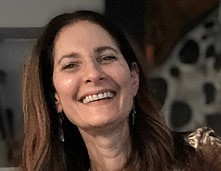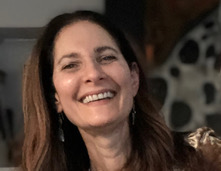My husband and I are still getting to know our new home. When we moved in last fall, the blueberry bushes were still putting out and the yard was a tangle of greenery, much of which we could not identify. We eked out two full months of socially distanced deck sitting with friends before the weather turned cold, at which time we retreated indoors, just the two of us, to weather the pandemic storm. From the giant windows that give us a panoramic view of our surroundings, we watched the winter fog slither in and out through the woods. We accidentally discovered, by flashlight, the bedding-down spot of a family of deer just outside our fence. And when we weren't delighting in our discoveries of fog and deer, we were watching "Chopped," snapping endless pictures of our dogs and yelling back and forth from our respective home offices about every big and small thing that crossed our minds.
Now it's spring. The Lenten roses have exploded into bloom, a riot of flowers that nearly obscures the entire path to our front door. The dogwoods and cherry blossoms are lighting up in the woods, the blueberry bushes are showing signs of life again and our lettuces are peeking through the soil. Everywhere we look, tiny chipmunks are scurrying about, seeking (I suspect) other chipmunks with whom to make more chipmunks.
But we're still in suspense. What will it look and feel like up here on this mountain when early spring softens to late spring and late spring melts into summer? What new plant life will show up in the yard and in the woods? What old ones will trade their blooms for leaves? Just how many chipmunks will call our yard home, and will they leave any lettuce for us?
Along with the mysteries of nature that await us in the seasons to come are the mysteries of our post-pandemic lives. My husband and I and most of our friends and family are fully vaccinated - a palpable relief, a joyful celebration - and look forward to re-entering the world we've shunned for a year. How good it will feel to hug again, to mindlessly walk in close orbit with others, to experience the simple pleasures of a meal eaten somewhere besides our own kitchen!
But I also can't help but wonder: Of everything that was put on hold - the relationships, the activities, the classes, the jobs - what will we resume, and what will we let lie dormant? Because, as social and print media keep reminding us, we don't have to pick up exactly where we left off. We can open the windows and look around, see what's there now that wasn't there a year ago. Maybe we like alone-time more than we realized we would. Maybe we had an inkling of this a year ago but ignored it, pushing ourselves to do things - shop, socialize, travel - that we didn't necessarily want to do but felt we should. Maybe it's time to usher in a whole different kind of spring, one that honors who and what we've always been, or what we've become, since the pandemic forced us inside our homes and inside ourselves.
This idea of a personal spring is far from original with me. "Pandemics are both catastrophes and opportunities," says author and historian Mark Bailey. And in her New York Times article, "What the History of Pandemics Can Teach Us About Resilience," Anna North writes, "It is worth remembering that in the wake of even the most devastating public health disasters, human social life and creativity have re-emerged in new and unexpected ways."
Which is not to make light of what people around the world have been through. Loneliness, financial hardship and the stress of figuring out how to manage children who are home all day has taken a toll on many people. Some have lost family and friends to COVID, while others have missed milestone celebrations, the weddings and funerals of loved ones, once-in-a-lifetime opportunities. Some have simply been set adrift, unmoored by the uncertainty and unable to navigate a way home.
I am not blind to the hardships of others. I am aware that I've had it comparatively easy. Adopting a little old dog at the start of the pandemic brought me great solace and joy. Moving into a new home has been a distraction and a delight. Even losing my job - as difficult as it was for a few months - has given me the impetus to pursue opportunities that, it turns out, have much greater value to me.
Psychologists Richard Tedeschi and Lawrence Calhoun coined the term "post-traumatic growth" to describe the personal growth we make as a result of something that calls into question everything we believed to be true about the world. Like, for example, the way a pandemic makes you realize you are much more vulnerable than you ever would have thought.
Still, there is opportunity in this moment. What might the months of unavoidable introspection have to tell me, besides that I am still basically an introvert despite my best efforts to appear otherwise, and that giving a voice to my creative impulses will always make me happier than an hour in the aisles of T.J.Maxx? What else do I have to learn, what else might come to pass as a result of what's already happened? What don't I know to anticipate (or dread)?
"You can't know about things you have yet to discover," wrote novelist Jonathan Raymond. This is our moment for post-traumatic growth. For most of us, it's unlike any we've had in our lifetime. So take a deep breath, throw open the windows and have a good look around.
Dana Shavin is an award-winning columnist and author of a memoir, "The Body Tourist." Email her at dana@danashavin.com and follow her on Facebook at Dana Shavin Writes. More at Danashavin.com.

